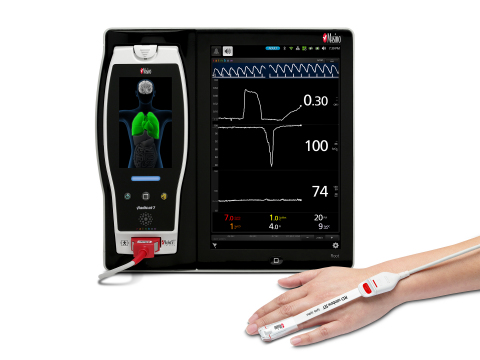NEUCHATEL, Switzerland– Masimo (NASDAQ: MASI) announced today the findings of a prospective, blinded observational study published in Annals of Intensive Care in which Dr. Jean-Baptiste Lascarrou and colleagues at the Centre Hospitalier Universitaire in Nantes, France evaluated the ability of Masimo ORi™ to predict mild hypoxemia during endotracheal intubation (ETI) in ICU patients.1 They concluded that the time between decrease in ORi and subsequent decrease in oxygen saturation (SpO2) “may allow preventive action,” and that a higher ORi value during preoxygenation was “independently protective against hypoxemia.”
ORi, available outside the U.S., is a noninvasive and continuous trending index that extends oxygen monitoring on patients on supplemental oxygen. Enabled by the multi-wavelength rainbow® Pulse CO-Oximetry platform, ORi is provided alongside oxygen saturation (SpO2) measured by clinically proven Masimo SET® pulse oximetry.
Noting the importance of optimizing preoxygenation in patients needing ETI, the researchers sought to evaluate whether ORi could provide early warning of impending hypoxemia during the procedure, because ORi “supplies information beyond the range explored by SpO2.” Of the 51 patients who met the inclusion criteria, ORi (alongside SpO2) was monitored using Masimo Radical-7® Pulse CO-Oximeters® and rainbow® fingertip sensors when preoxygenation began. Values were recorded every two seconds, and attending clinicians were not aware of these values. The primary endpoint measured was the time between ORi decreasing below 0.4 and the onset of mild hypoxemia (defined as SpO2 < 97%). Secondarily, the investigators evaluated whether a decline in ORi during preoxygenation predicted the occurrence of mild hypoxemia during ETI.
Analyzing areas under the ROC curve, the researchers found that ORi during preoxygenation predicted SpO2 < 97% during intubation (0.73; 95% confidence interval of 0.58 – 0.88). By contrast, SpO2 at the end of preoxygenation was “poorly predictive” (0.54; 95% CI 0.40 – 0.67). Using univariate analysis, they found that a higher ORi value during preoxygenation was associated with a less frequent occurrence of SpO2 < 97% (odds ratio of 0.09; 95% CI 0.01 – 0.69, p = 0.0199) and that “the highest ORi value during preoxygenation remained significantly associated with a lower risk of SpO2 < 97% during ETI, after adjustment for ETI duration and BMI (odds ratio of 0.76; 95% CI 0.61 – 0.95, p = 0.0141).”
The researchers concluded, “The median time between the ORi decrease below 0.4 and the SpO2 decrease below 97% during the apneic period was 81 seconds [34–146]. A higher ORi during preoxygenation was independently associated with a lower risk of mild hypoxemia (SpO2 < 97%).”
The researchers noted that the median 81 seconds of forewarning “may allow immediate intubation, early face-mask ventilation, insertion of a supraglottic device, or a call for help in the event of intubation difficulties.” In addition, they noted that “ORi monitoring can help identify patients who do not increase their oxygen reserve despite preoxygenation and are therefore at [increased] risk of desaturation during ETI. These patients may benefit from a longer preoxygenation period and/or a change in device.” The authors further noted that “an ORi decline might lead to the detection of a fault in the preoxygenation technique such as an insufficient oxygen flow rate or major leaks.”
As a study limitation, the authors noted that their findings cannot be generalized to ICU patients who did not meet the inclusion criteria, as those patient cohorts remain to be evaluated. The inclusion criteria for this study were ICU admission with a need for ETI and an SpO2/FiO2 ratio above 214. The SpO2/FiO2 ratio was measured during noninvasive ventilation or high-flow oxygen therapy; for conventional oxygen therapy, the fraction of inspired oxygen (FiO2) was calculated as FiO2 = 0.21 + O2 [rate in L/min] x 0.03.
ORi has not received FDA 510(k) clearance and is not available for sale in the United States.


